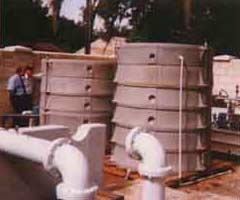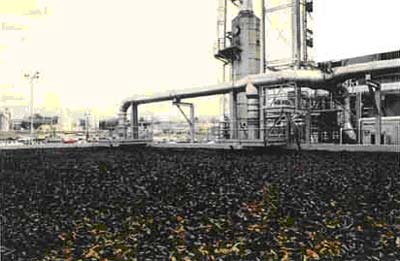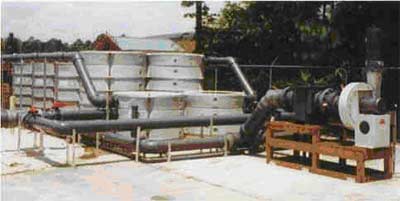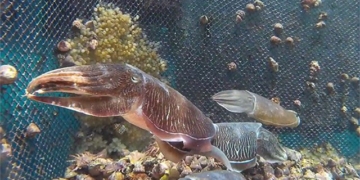What is Biological Filtration?
Biological filtration is a relatively new method for treating pollution. It presents an attractive approach for dealing with odorous gases and low-concentration volatile organic compounds.
 A common design for a biological filtration system resembles a large box; some systems can be as big as a basketball court, while others may be as small as one cubic yard (0.76 m3). The primary principle of the treatment system is to enable bacteria to come into contact with pollutants in exhaust gases. This exhaust filtration system serves as a habitat for filter media and a breeding ground for microorganisms. Within this system, microorganisms form a biofilm, a thin and moist layer surrounding the filter media. During the filtration process, exhaust gases are slowly pumped through the filtration system, allowing pollutants to be absorbed by the filter media. Polluting gases are adsorbed by the biofilm, where microorganisms break them down to produce energy and byproducts, CO2 and H2O, according to the following equation:
A common design for a biological filtration system resembles a large box; some systems can be as big as a basketball court, while others may be as small as one cubic yard (0.76 m3). The primary principle of the treatment system is to enable bacteria to come into contact with pollutants in exhaust gases. This exhaust filtration system serves as a habitat for filter media and a breeding ground for microorganisms. Within this system, microorganisms form a biofilm, a thin and moist layer surrounding the filter media. During the filtration process, exhaust gases are slowly pumped through the filtration system, allowing pollutants to be absorbed by the filter media. Polluting gases are adsorbed by the biofilm, where microorganisms break them down to produce energy and byproducts, CO2 and H2O, according to the following equation:
Organic Pollutant + O2 —> CO2 + H2O + heat + biomass
History
While the use of biological filtration systems is not yet widespread in the United States, hundreds of biological filtration systems have been successfully implemented and proven effective in Europe (the Netherlands, New Zealand, Germany) and Japan. Historically, biological filtration systems were primarily designed to treat odors from wastewater treatment plants, recycling facilities, and composting processes. Over time, their application broadened to include the treatment of volatile organic compounds and other organic substances.
Here are some historical milestones in the development of biological filtration systems:
Odor treatment has been underway since the 1950s, during which time soil filtration systems or small dripping biological filters were often used. Odorous gases typically include hydrogen sulfide or mercaptans and other sulfur compounds. The treatment of volatile organic compounds has only recently been applied and has gained popularity over the last decade, with ongoing research in this area. For instance, some recent studies have shown that biological filtration systems can be used to treat aromatic compounds, fats, alcohols, aldehydes, organic acids, acrylates, carbolic acid, amines, and ammonia.
Description of the Treatment Process
Biological filtration systems provide an environment for microorganisms to develop and decompose odorous gases and organic pollutants in exhaust gases. The system consists of a closed chamber containing microorganisms and absorbing moisture, retaining it in the filter media. The filter media is designed to have a high moisture absorption capacity, durability, and minimal impact on the airflow passing through it.
 |
|
Biological filter with a layer of filter media (6000 ft2) at the Monsanto plant
|
Smaller systems, often featuring multiple layers of filter media, are illustrated in the following image:
 |
These units of filter media, called “Biocubes,” are designed by EG&G Corporation, measuring approximately 7 ft in height and 6 ft in diameter. The use of multiple layers of this type of filter media helps prevent compression of the filter media and allows airflow to pass through without creating pathways through the filter media. Furthermore, it facilitates maintenance and replacement of the filter media.
During the biological filtration process, the pollutant gases are moistened and then pumped into a chamber beneath the filter media. As the gases traverse the filter media, pollutants are absorbed and decomposed. The treated exhaust gases are released into the atmosphere from the top of the filtration system. Most biological filtration systems today achieve treatment efficiencies for odors and volatile organic compounds exceeding 90%. However, a limitation of this method is that it can only treat exhaust gases with low concentrations of pollutants.
Filter Media
The moist layer of filter media creates favorable physical and chemical conditions for converting pollutants from gas to liquid phase and for the biological degradation of these pollutants by the biofilm. The mechanisms of biological filtration include adsorption, absorption, and microbial degradation. The microorganisms in the biofilm continuously absorb and metabolize the pollutants, converting them into end products of water, CO2, and various salts.
Typical filter media are mixtures of composting substrates, soil, heather, plastic, and wood byproducts. The filter media provide a large surface area for the absorption and adsorption of pollutants. Additionally, they serve to supply nutrients to the microorganisms. Some types of filter media do not sufficiently meet the nutrient requirements for microorganisms; thus, adjustments may be necessary by adding nitrogen and phosphorus compounds.
Filter media typically have a lifespan of 5 to 7 years before needing replacement.
Key considerations when selecting filter media include:
Design Parameters
Area
Area is a primary consideration in the design of biological filtration systems. To handle an airflow of approximately 30 ft3/minute, a biological filtration system may require an area of 25 ft2. For larger airflow rates, larger areas are necessary, which may be equivalent to the area of a basketball court, as previously mentioned.
Chemical Composition and Concentration of Pollutants in Exhaust Gases
Analyzing the chemical composition and concentration of pollutants in exhaust gases is essential to determine if biological filtration is an appropriate solution. Biological filtration systems operate effectively when the concentrations of pollutants (insoluble in water) are low.
Residence Time
Residence time refers to the duration that microorganisms are in contact with the exhaust gas flow and is calculated using the following formula:
RT = Total volume of the voids in the filter media layer / exhaust gas flow rate
Longer residence times generally yield higher treatment efficiencies. However, during the design process, it is necessary to minimize residence time to accommodate larger flow rates. Typically, the residence time for biological filtration systems ranges from 30 seconds to 1 minute.
Humidity
The humidity of the exhaust gas flow being treated is crucial, as it maintains the moisture levels necessary for the biofilms. Therefore, the exhaust gas flow is usually pumped through a humidification system before being introduced into the biological filtration system to ensure that the humidity of the incoming exhaust gas flow exceeds 95%.
pH Control
The byproducts of the biological degradation process are organic acids. To maintain the pH of the system within an appropriate range for microbial activity, it is necessary to add pH buffer solutions.
Filter Media
Filtration materials may include peat, heather, compost, activated carbon, or other suitable materials. Generally, these materials must have the ability to provide nutrients for microorganisms and should not cause significant pressure drop in the airflow. Additionally, the moisture content of the filtration materials must be maintained at 30 – 60% to support the growth of microbial populations. Therefore, in addition to exhaust humidifying equipment, it is common to install a water spraying system for the layers of filtration materials.
Pressure Drop
The pressure drop of the airflow as it passes through the filtration material layer should be minimized. If the filtration layer creates significant resistance to the air source, additional energy will be required for the blowers, increasing the treatment costs. The resistance to the air source depends on the moisture content and porosity of the filtration layer. Increased moisture reduces the porosity of the filtration material, which contributes to higher resistance in the airflow. For typical systems, the pressure drop ranges from 1 – 10 hPa.
Maintenance
When first put into operation, the system should be monitored once a week. After the system stabilizes and resolves all potential issues, the monitoring frequency can be reduced to once every two weeks or monthly.
Advantages and Disadvantages of Biological Filtration Systems
Advantages
-
The main advantage is low cost, low operating expenses, and minimal chemical use.
-
Flexible design, allowing adaptation to all types of industries and factory sizes.
-
Biological filtration systems are effective in treating odors, volatile organic compounds, and toxins. The treatment efficiency is typically over 90% for emissions with pollutant concentrations.
-
A variety of filtration materials, microorganisms, and operational conditions can be applied to meet treatment needs.
Disadvantages
-
Biological filtration systems cannot treat pollutants with low adsorption potential and slow biodegradation rates, such as chlorinated volatile organic compounds.
-
Pollution sources with high chemical concentrations require larger systems and more space for installation of biological filtration.
-
Pollution sources with highly variable pollutant release levels will affect the microbial community as well as their treatment efficiency.
-
The time required for microorganisms to adapt to the environment and form biofilms can range from weeks to months, especially when treating volatile organic compounds.
Commercialization
Over the past 15 years, more than 50 biological filtration systems using compost as filter material have been commercially installed in Europe and the United States.
The use of biological filtration systems to treat volatile organic compounds has been applied in the following industries:
-
Chemical and petrochemical technology
-
Oil and gas technology
-
Synthetic plastics technology
-
Paint and ink production technology
-
Pharmaceutical technology
-
Waste and wastewater treatment
-
Soil and groundwater remediation
The use of biological filtration systems for odor treatment has been applied in the following industries:
-
Sewage treatment
-
Waste and wastewater treatment in slaughterhouses
-
Recycling technologies
-
Gelatin and adhesive production plants
-
Meat and agricultural processing technology
-
Tobacco, cocoa, and sugar production technology
-
Production technology for spices and artificial flavors.
Selvi B. Anit & Robert J. Artuz
Translated by: Lê Hoàng Việt


















































